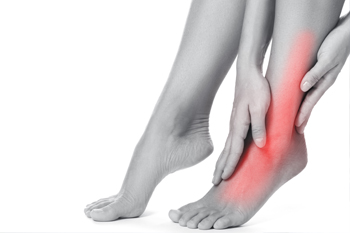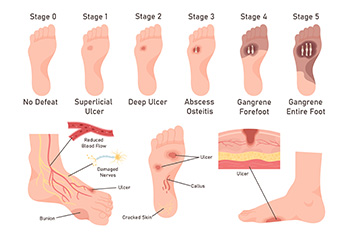Items filtered by date: May 2025
Foot and Ankle Issues That Develop Without Injury

Many foot and ankle conditions can occur without a specific injury. These problems often result from gradual changes in foot structure, genetics, underlying health conditions, or daily habits. Common examples include bunions, hammertoes, and flat feet, which may form over time due to inherited traits or improper footwear. Plantar fasciitis and heel spurs can develop from repetitive strain or standing for long hours. Arthritis in the joints of the toes or ankles may cause stiffness, swelling, and reduced mobility as part of the aging process. Nerve disorders like peripheral neuropathy and tarsal tunnel syndrome can also affect the feet, even without trauma. Circulatory issues like peripheral arterial disease may lead to foot pain, slow-healing wounds, or changes in skin color. If you notice discomfort, numbness, or changes in your feet or ankles that are not related to an injury, it is suggested that you visit a podiatrist for a complete evaluation.
Foot Pain
Foot pain can be extremely painful and debilitating. If you have a foot pain, consult with Susan Yeager, DPM from Yeager Foot and Ankle Center. Our doctor will assess your condition and provide you with quality foot and ankle treatment.
Causes
Foot pain is a very broad condition that could be caused by one or more ailments. The most common include:
- Bunions
- Hammertoes
- Plantar Fasciitis
- Bone Spurs
- Corns
- Tarsal Tunnel Syndrome
- Ingrown Toenails
- Arthritis (such as Gout, Rheumatoid, and Osteoarthritis)
- Flat Feet
- Injury (from stress fractures, broken toe, foot, ankle, Achilles tendon ruptures, and sprains)
- And more
Diagnosis
To figure out the cause of foot pain, podiatrists utilize several different methods. This can range from simple visual inspections and sensation tests to X-rays and MRI scans. Prior medical history, family medical history, and any recent physical traumatic events will all be taken into consideration for a proper diagnosis.
Treatment
Treatment depends upon the cause of the foot pain. Whether it is resting, staying off the foot, or having surgery; podiatrists have a number of treatment options available for foot pain.
If you have any questions, please feel free to contact our office located in Redding, CA . We offer the newest diagnostic and treatment technologies for all your foot care needs.
Ways Running Can Lead to Foot Pain

Running places repeated stress on the foot, often causing pain in the hindfoot, midfoot, or forefoot. Each section plays a vital role in absorbing shock and propelling the body forward. Foot pain from running may arise from overuse, improper footwear, or biomechanical imbalances. Hindfoot discomfort often involves the heel or Achilles tendon, while midfoot pain can result from stress to the arch or ligaments. Forefoot pain is commonly linked to conditions like metatarsalgia or neuromas. Sprains and fractures may also occur from repetitive impact or uneven terrain. Sports injuries are common, especially when training is intense or form is poor. If you like to run and are experiencing foot pain, it is suggested that you contact a podiatrist who can offer appropriate treatment solutions that can get you back to enjoying this sport.
Sports related foot and ankle injuries require proper treatment before players can go back to their regular routines. For more information, contact Susan Yeager, DPM of Yeager Foot and Ankle Center. Our doctor can provide the care you need to keep you pain-free and on your feet.
Sports Related Foot and Ankle Injuries
Foot and ankle injuries are a common occurrence when it comes to athletes of any sport. While many athletes dismiss the initial aches and pains, the truth is that ignoring potential foot and ankle injuries can lead to serious problems. As athletes continue to place pressure and strain the area further, a mild injury can turn into something as serious as a rupture and may lead to a permanent disability. There are many factors that contribute to sports related foot and ankle injuries, which include failure to warm up properly, not providing support or wearing bad footwear. Common injuries and conditions athletes face, including:
- Plantar Fasciitis
- Achilles Tendinitis
- Achilles Tendon Rupture
- Ankle Sprains
Sports related injuries are commonly treated using the RICE method. This includes rest, applying ice to the injured area, compression and elevating the ankle. More serious sprains and injuries may require surgery, which could include arthroscopic and reconstructive surgery. Rehabilitation and therapy may also be required in order to get any recovering athlete to become fully functional again. Any unusual aches and pains an athlete sustains must be evaluated by a licensed, reputable medical professional.
If you have any questions please contact our office located in Redding, CA . We offer the newest diagnostic and treatment technologies for all your foot and ankle needs.
Early Intervention for Diabetic Foot Ulcers

Diabetic foot ulcers are open sores that typically form on the bottom of the feet in individuals with diabetes. These ulcers progress through several stages, each requiring careful management. In the initial stage, the skin breaks down, often due to minor injuries or pressure. As the ulcer develops, it can deepen, affecting the underlying tissue and potentially reaching the muscle or bone. At advanced stages, infection sets in, leading to serious complications like gangrene, which may necessitate loss of limb. Seeking early treatment is critical because the earlier the intervention, the better the chances of preventing progression. Early treatment can stop the ulcer from worsening, reduce the risk of infection, and promote faster healing. If you have diabetes, it is strongly suggested that you schedule regular appointments with a podiatrist to stay on top of any developing foot problems, preventing complications.
Diabetic foot care is important in preventing foot ailments such as ulcers. If you are suffering from diabetes or have any other concerns about your feet, contact Susan Yeager, DPM from Yeager Foot and Ankle Center. Our doctor can provide the care you need to keep you pain-free and on your feet.
Diabetic Foot Care
Diabetes affects millions of people every year. The condition can damage blood vessels in many parts of the body, especially the feet. Because of this, taking care of your feet is essential if you have diabetes, and having a podiatrist help monitor your foot health is highly recommended.
The Importance of Caring for Your Feet
- Routinely inspect your feet for bruises or sores.
- Wear socks that fit your feet comfortably.
- Wear comfortable shoes that provide adequate support.
Patients with diabetes should have their doctor monitor their blood levels, as blood sugar levels play such a huge role in diabetic care. Monitoring these levels on a regular basis is highly advised.
It is always best to inform your healthcare professional of any concerns you may have regarding your feet, especially for diabetic patients. Early treatment and routine foot examinations are keys to maintaining proper health, especially because severe complications can arise if proper treatment is not applied.
If you have any questions, please feel free to contact our office located in Redding, CA . We offer the newest diagnostic and treatment technologies for all your foot care needs.
Signs of Foot Stress Fractures

Stress fractures in the feet are hairline cracks in the bone caused by repetitive stress or overuse, often affecting the long bones of the foot. Stress fractures typically develop gradually, with early signs like localized pain that worsens with activity and improves during rest. Swelling, bruising, and tenderness when pressing on a specific area of the foot may also occur. Runners or other athletes who increase exercise intensity too quickly, wear worn-out shoes, or regularly train on hard surfaces are more likely to develop stress fractures. Women with low bone density may face added risk. A podiatrist can diagnose stress fractures using a clinical exam and imaging tests, such as MRI or bone scans, when X-rays do not reveal the injury. Depending on the severity of the fractures, treatment may involve wearing protective footwear, modified activity, or using crutches to reduce pressure on the affected area. In some cases, surgery may be needed to ensure proper healing. If you have symptoms of stress fractures in the feet, it is suggested that you schedule an appointment with a podiatrist for appropriate treatment options.
Activities where too much pressure is put on the feet can cause stress fractures. To learn more, contact Susan Yeager, DPM from Yeager Foot and Ankle Center. Our doctor can provide the care you need to keep your pain free and on your feet.
Dealing with Stress Fractures of the Foot and Ankle
Stress fractures occur in the foot and ankle when muscles in these areas weaken from too much or too little use. The feet and ankles then lose support when walking or running from the impact of the ground. Since there is no protection, the bones receive the full impact of each step. Stress on the feet can cause cracks to form in the bones, thus creating stress fractures.
What Are Stress Fractures?
Stress fractures occur frequently in individuals whose daily activities cause great impact on the feet and ankles. Stress factors are most common among:
- Runners
- People affected with Osteoporosis
- Tennis or basketball players
- Gymnasts
- High impact workouts
Symptoms
Pain from the fractures occur in the area of the fractures and can be constant or intermittent. It will often cause sharp or dull pain with swelling and tenderness. Engaging in any kind of activity which involves high impact will aggravate pain.
If you have any questions please contact our office located in Redding, CA . We offer the newest diagnostic and treatment technologies for all your foot and ankle needs.
